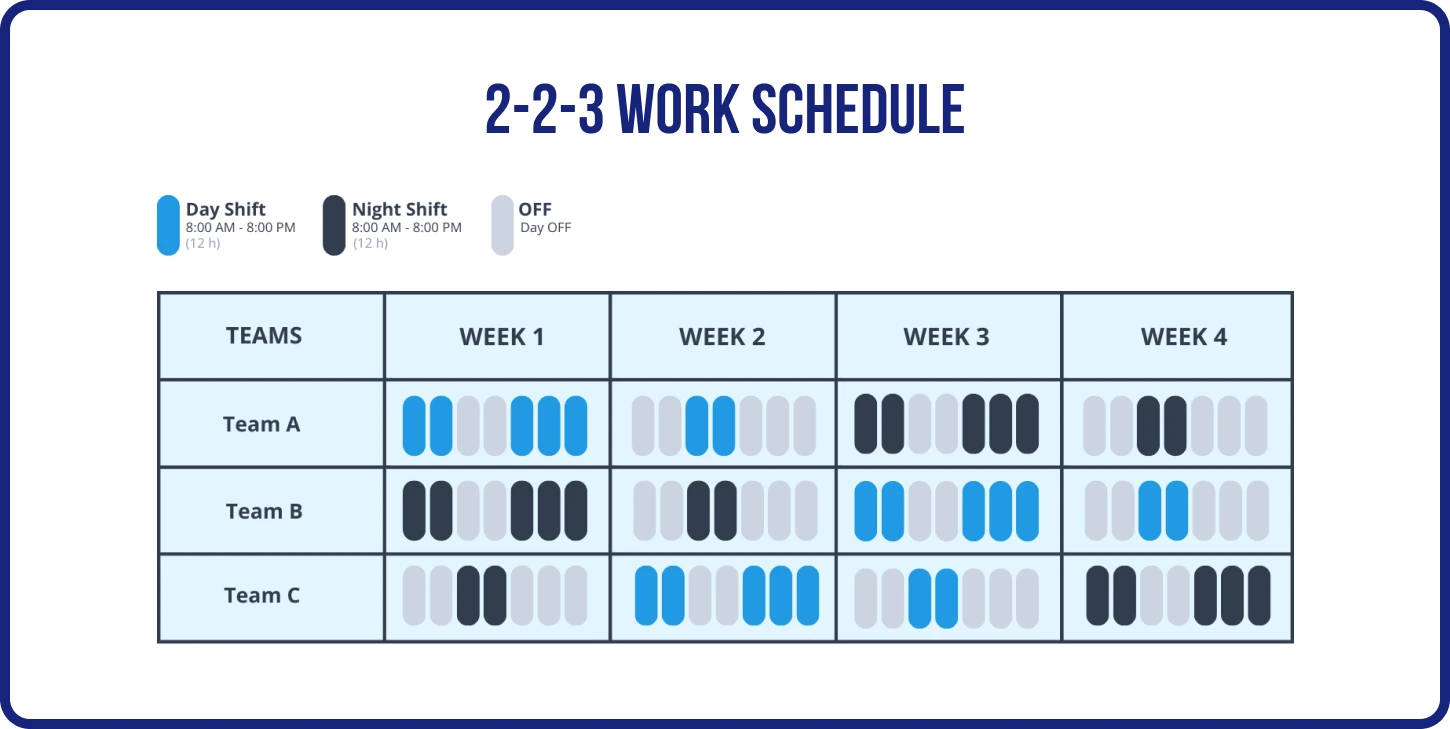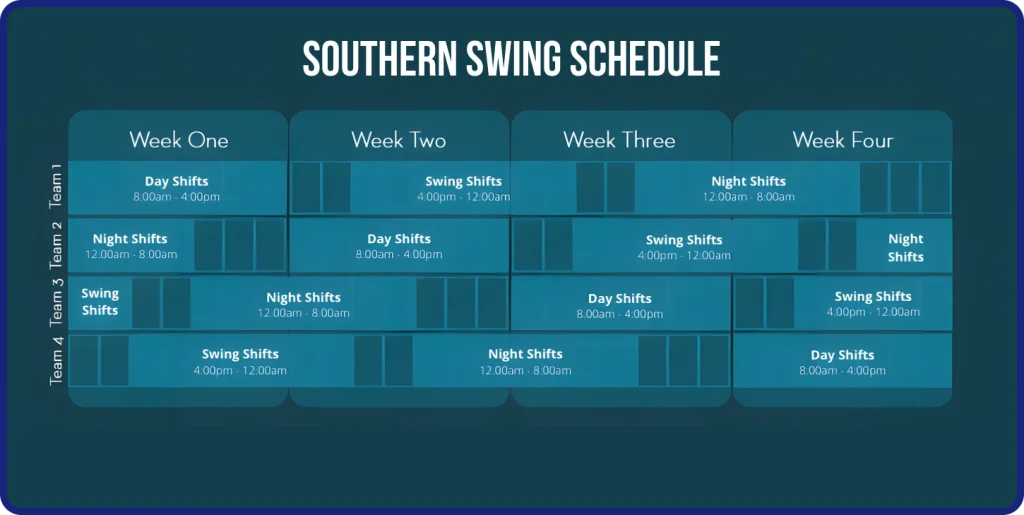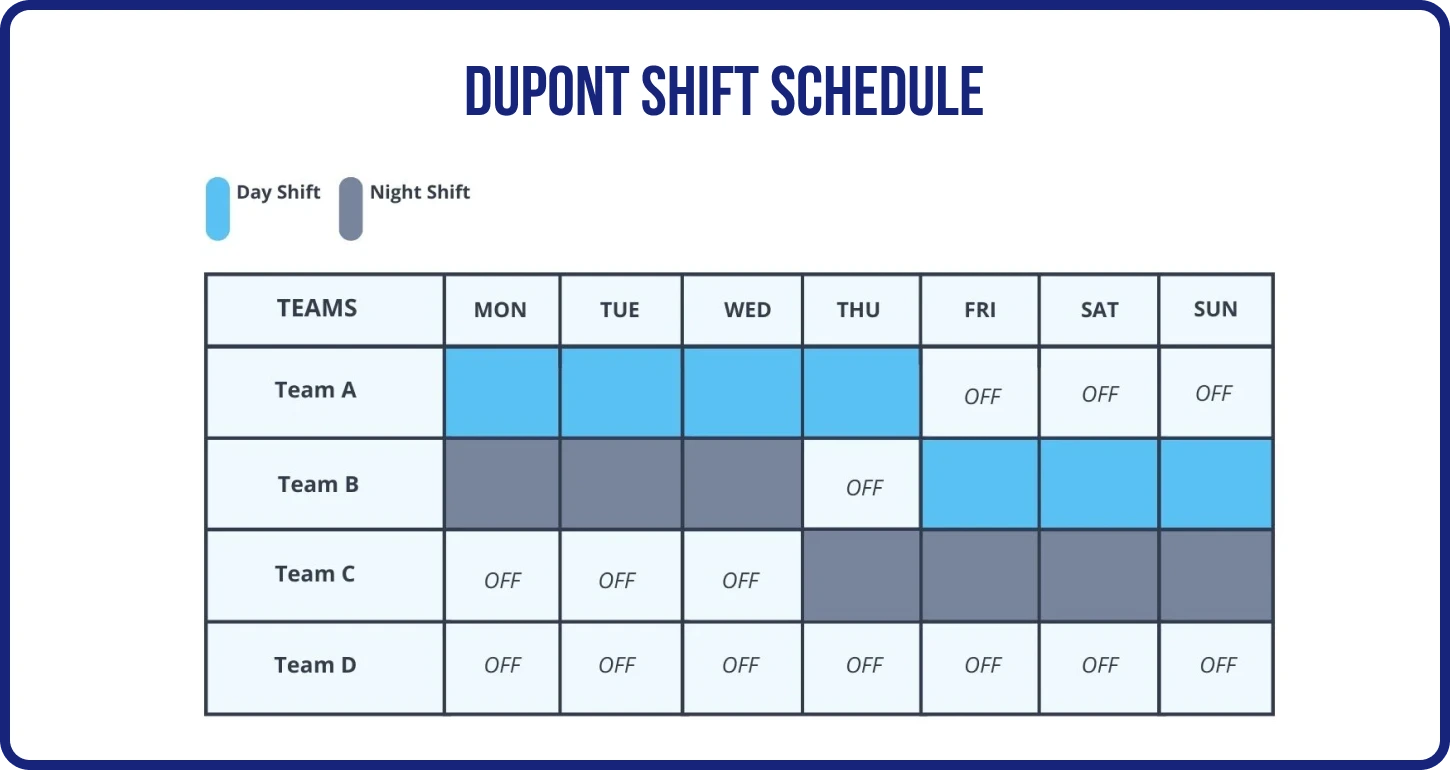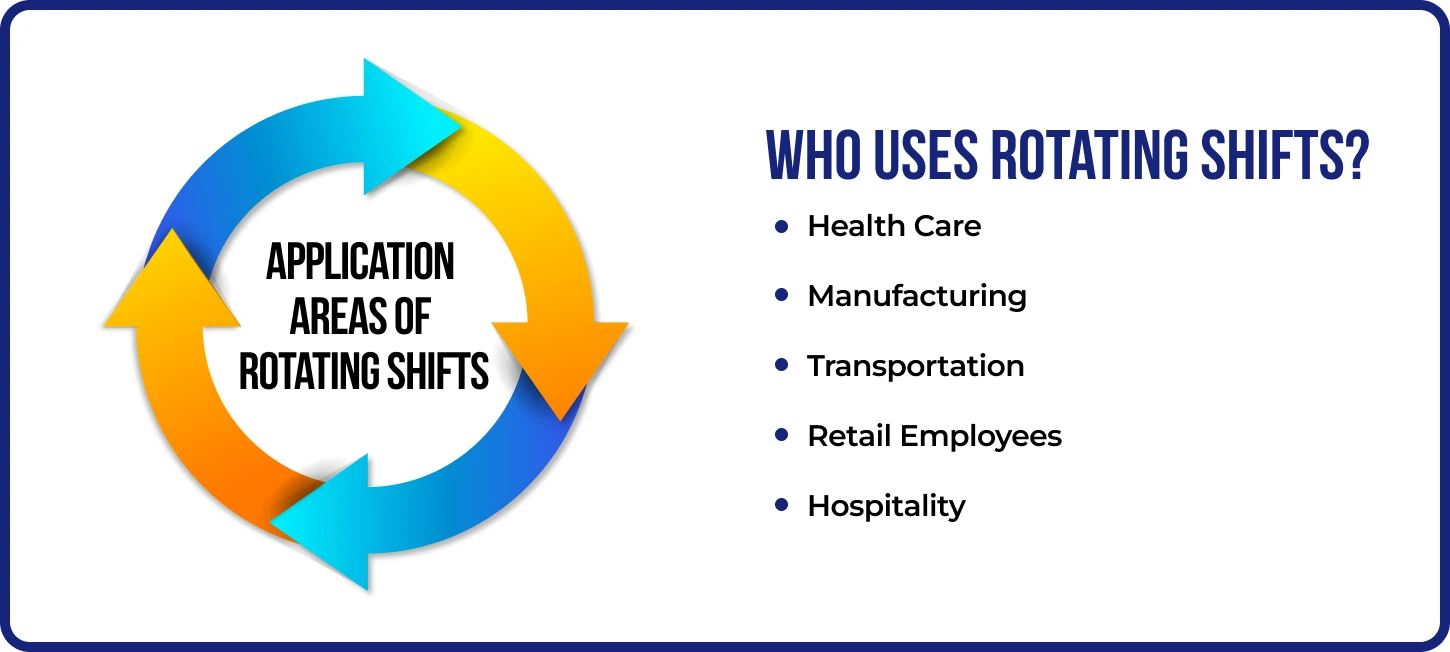A burning question circulating on the internet these days is whether rotating shifts or schedules—whatever you may call them—are the key to boosting productivity and work-life balance.
To answer this question, we would like to put forth a fact that around 16% of the US workforce now work in rotating schedules, and this strategy is becoming more common across industries.
In a rotating schedule, staff members switch between day, night, and evening shifts on a regular basis, with the primary aim of reducing burnout and promoting flexibility.
From an employer’s viewpoint, this system ensures 24×7 coverage while boosting productivity. Again, for employees, rotating shifts can provide greater work-life balance and opportunities for varied hours, thus helping them manage personal commitments more effectively.
Today, we will be discussing what is actually meant by rotating shifts, how it works, its importance, different types, the difference between fixed shifts and rotating shifts, and more. After going through this blog, you will get a clear idea of whether this is the right fit for your business. So, let’s start.
What Are Rotating Shifts?
Rotating shifts involves employees working different shifts on a scheduled cycle, such as day, evening, and night. Such a schedule allows businesses to operate 24/7 while ensuring no one stays on the same shift permanently, thus promoting flexibility and fairness among staff.
For example, in a manufacturing industry, employees may work the day shift (6 AM to 2 PM) for one week, the afternoon shift (2 PM to 10 PM) the following week, and the night shift (10 PM to 6 AM) the week after. This rotation helps balance the workload and prevent employee burnout.
How do Rotating Shifts Work?
Rotating shifts involves employees switching between different work shifts on a recurring schedule, such as mornings, evenings, and nights. The shifts are generally 8-12 hours long.
This approach ensures continuous operations in industries like healthcare, manufacturing, and customer service while distributing the workload evenly among team members. Workers typically spend a set period (like one week) on each shift before rotating to the next.
Why is a Rotating Shift Required?
Rotating shifts are extremely important in industries that operate 24/7, such as healthcare, manufacturing, transportation, construction, and customer service. They ensure continuous operations, allowing businesses to provide round-the-clock service while distributing the workload evenly among team members. By rotating shifts, organizations can prevent worker fatigue from constant night or early morning shifts, thus improving employee well-being and productivity.
For example, in emergency services, a rotating schedule is critical to ensure there’s always a fresh and alert team on duty. This schedule promotes flexibility, fairness, and a balanced work-life structure, thereby improving overall job satisfaction. Also, in the manufacturing industry, staff might need to be prepared to work on the floor, perform maintenance work, and, if the situation demands, operate CNC machines.
5 Different Types of Rotating Shifts
As aforementioned, rotating shifts are absolutely essential for businesses that operate 24/7. This is because it not just ensures handsome productivity but takes care of employee well-being as well.
In this section, we will examine the various styles of employee rotation schedules, thus helping you choose one that best suits your organization.
The Pitman Shift Schedule
In this rotating schedule, employees enjoy every other weekend off to have time to participate in some social and family events during regular hours.
The shifts are generally 12 hours long and have four teams working in rotation. To ensure that no staff members work overtime, they usually work no more than three days in a row.
This schedule ensures 24/7 coverage with absolutely no overtime. Employees also enjoy long stretches of days off for work-life balance.
Here’s how the Pitman shift schedule pattern goes on:
- Two shifts on, followed by two days off.
- Two shifts on, followed by three days off.
- Three shifts on, followed by two days off.

Workers switch timing when the two-week cycle is complete, i.e., they start working night shifts and vice versa.
2-2-3-2-2-3 Shift Schedule
- This rotating shift follows a 28-day cycle. In this schedule, 12-hour shifts are rotated in the following pattern:
- Two-day shifts
- Two days off
- Three-day shifts
- Two days off
- Two-day shifts
- Three days off
- Two-night shifts
- Two-day shifts
- Three-night shifts
- Two days off
- Two-night shifts
- Three days off

The good thing about this rotating schedule is that workers get adequate time off without having to work more than three consecutive days. This type of schedule is mainly found in the healthcare and construction industry, where employees work 12-hour shifts followed by multiple days off.
Southern Swing Schedule
- The southern swing schedule employs three 8-hour shifts throughout the month for four teams. Here’s how this rotating shift works:
- Seven-day shifts
- Two days off
- Seven-day shifts
- Two days off
- Seven-night shifts
- Three days off

In this method, employees have to work only eight hours, reducing employee burnout.
The Dupont Shift Schedule
In the Dupont shift schedule system, there are four teams, each working 12-hour shifts. The shift rotates from day to night in a four-week cycle. Here’s an example:
- Four-day shifts, then three days off
- Three-night shifts, then one day off, followed by three day shifts
- Three days off, then three-night shifts.
- Seven days off
Since this rotating shift includes multiple days off, workers have enough time to recharge themselves. At the end of the cycle, these days off build up to a week-long break.

Modified Shift
Modified shifts involve customized shift patterns based on company requirements. They are typically variations of other schedules.
The best part about this shift is that it allows flexibility in scheduling. Employees also benefit from being able to adapt to personal preferences.
Fixed Shifts Versus Rotating Shifts
Choosing between fixed shifts and rotating shifts can significantly impact business operations and employee satisfaction. Understanding the different aspects where they differ from each other will help you create a work schedule that balances productivity and employee well-being. So, let’s take a look at them.
| Aspect | Fixed Shifts | Rotating Shifts |
| Definition | Fixed shifts involve employees working the same set of hours every day or week. | Rotating shifts require employees to switch between different time slots, such as morning, afternoon, and night. |
| Work-Life Balance | Predictable schedules allow for a steady routine. | Flexibility can improve adaptability and reduce monotony. |
| Employee Fatigue | Low variability may lead to burnout over time. | Shift variety negates the chances of burnout. |
| Productivity | Repetitive hours may cause a drop in productivity. | Rotating shifts allows for higher engagement. |
| Health Impact | Consistent night shifts can disrupt circadian rhythm. | Varied shifts lead to better sleep and health. |
| Team Collaboration | Limited exposure to different teams. | Promotes teamwork and exposure across different teams. |
| Adaptability | Rigid; Difficult to adapt to unexpected changes. | Rotating shifts ensure better adaptability. |
Benefits of Rotating Shifts
Rotating shifts confer several benefits, both for the employers and employees. Let’s take a look at them:

Increased Coverage and Flexibility
Rotating schedules or shifts allows businesses to operate 24/7 by ensuring consistent staffing throughout the day and night. Such flexibility in scheduling helps meet fluctuating business demands and customer requirements more effectively.
Improved Employee Skill Development
Rotating shifts exposes employees to various roles and responsibilities, helping them become more adaptable and versatile. Also, employees who work across different shifts gain greater job experience and skill enhancement, potentially opening doors for career advancement.
Enhanced Work-Life Balance
By alternating shifts, employees can more effectively plan personal time and balance work and personal commitments. It also offers opportunities for time off during unconventional hours, giving employees more control over their schedules.
Fairness and Equity
Shift rotation ascertains that no one employee is stuck working undesirable hours, thus promoting a fair and equitable work environment. Such a system negates the perception of unfair workload distribution or favoritism, fostering a more collaborative work environment.
Who Uses Rotating Shifts?
Rotating shifts are quite common among various industries that call for continuous operations and flexibility. Let’s take a look at the different sectors where rotating shifts are most prevalent:

Health Care
Doctors, nurses, and medical staff work in rotating schedules to ensure 24/7 patient care in hospitals and emergency services. Caregivers in rehabilitation centers or nursing homes also count on rotating shifts for round-the-clock support.
Manufacturing
Factories and production facilities often employ rotating shifts to keep operations running seamlessly and meet production goals. Workers in industries like electronics, automotive, and food processing prefer varied shifts to ensure continuous output.
Transportation
Pilots, drivers, and public transport workers work in rotating schedules to maintain transportation services across different time zones and regions. Logistics and freight companies also use rotating shifts to manage the constant flow of goods and deliveries.
Retail Employees
Retail stores operating for extended hours or with 24/7 operations depend on rotating shifts to staff customer service and maintain store operations. Stocking and inventory management often work during non-peak hours, making rotating shift work a must.
Hospitality
Hotels, restaurants, and event venues employ rotating shifts to accommodate guests at all times and ensure consistent service day and night. Food service, front desk staff, and housekeeping teams work varied hours to accommodate guest requirements.
So, as you can well understand, rotating shifts are a must in these industries to maintain operations and serve customers effectively.
Tips for Rotating Shifts
Now, that you have got a thorough idea of the different types, benefits, and application areas of rotating shifts, let’s take a look at some powerful tips to practice such shifts, both from the viewpoint of employers and employees.
For Employees
- Establish A Consistent Sleep Routine: Prioritize sleep by maintaining a regular sleep schedule, even on off days, to help your body adjust to shift changes.
- Manage Your Nutrition: Eat balanced meals and avoid heavy or sugary foods before bedtime to improve sleep quality and energy levels.
- Communicate with Your Employer: Discuss any challenges with your shifts and request adjustments, if necessary, to improve your work-life balance.
- Monitor Your Health: You should regularly check in on your physical and mental health to ensure you get enough rest and stay active outside of work.
- Stay Organized: Track your schedule, tasks, and personal commitments to reduce stress and manage your team effectively.
For Employers
- Provide Clear Schedules and Advance Notice: Employers can share rotating shift schedules well in advance to give employees time to adjust and plan their personal lives.
- Promote a Healthy Work Environment: Rotating shifts encourages breaks, provides adequate time for meals and rest, and supports employees in maintaining a healthy lifestyle. This, in turn, promotes a healthy work environment.
- Offer Flexibility and Shift Preferences: Rotating shift work allows employees to indicate their shift preferences when possible, offering greater flexibility and reducing burnout.
- Monitor and Address Employee Fatigue: You can regularly check in with employees to ensure they are coping with rotating shifts and address any signs of stress or fatigue proactively.
Conclusion
So, we hope, by now, you have a fair idea of the various nitty-gritty involved with rotating shifts. This technique distributes work hours across various timeframes, thus allowing businesses to meet fluctuating demands and cover extended operational hours. Implement this method to ensure a healthy, balanced, and efficient working environment.

If you want to track the time your employees work on different rotating schedules, be it morning, afternoon, or night shifts, ClockDiary is the one for you. It allows you to track time both manually and automatically, thereby giving you a comprehensive overview of clock-in and clock-out times and hours worked.

You can also plan and allocate tasks efficiently, thus ensuring employees know when and what to work on. Track shifts, monitor employees, and maintain transparency in project timelines only with ClockDiary. Get in touch with us to incorporate this much sought-after software into your organization and feel the difference for yourself.

FAQs:
A rotating shift is a work schedule where employees work different shifts on different days, such as the day shift one day, the afternoon shift the next, and the night shift the third day. Shifts can rotate daily, weekly, or monthly.
A 24/7 rotating shift is a work schedule that ensures a business is staffed 24/7 by having team members work different shifts over 24 hours. This type of shift is generally followed in industries where all-time availability is a must, such as emergency services, healthcare, and transportation.
A 4-shift routine is a scheduling system in which staff members work in four rotating shifts, typically covering a 24-hour period to ensure continuous operations. It allows for balanced workloads, with employees alternating between day, afternoon, and night shifts.
A 4-3-3-4 shift pattern involves employees working four consecutive days, followed by three days off, then working three consecutive days, and ending with four days off. This rotating schedule helps maintain work-life balance while ensuring continuous coverage over a 14-day cycle.

